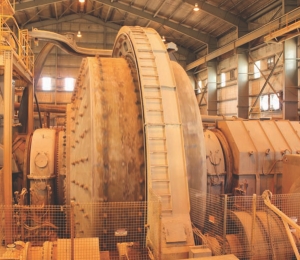ULAANBAATAR, MONGOLIA — Walking the halls of Centerra Gold’s (CG-T) modern office overlooking the city’s political heart, Sukhbaatar Square, the president of Centerra’s local operating subsidiary Boroo Gold, John Kazakoff, gestures towards a display case full of awards from the Mongolian government.
“We are recognized as leaders in safety and environmental standards, and we’re the leading taxpayer,” Kazakoff beams. While the plaques are proof the company is a successful mine operator in this new democracy, it is still a challenge to manoeuvre through Mongolia’s changing regulatory environment.
Some 110 km northwest of Ulaanbaatar at its Boroo mine — the largest operating gold mine in Mongolia — Centerra is winding things down as the operation moves towards the end of its life.
Managers now must decide how to process remaining ore deposits, having already mined 1.4 million oz. gold from the mine’s opening in 2004 until the end of 2009.
There is enough ore at Boroo to last until next February, say company officials, who are pondering whether to run the remaining ore through the existing mine plant or spend $14 million on a new biooxidation plant that will recover a greater amount of gold from the sulphide ore.
Boroo’s heap-leach pad, the only one in the country so far, has been ready for over a year, with Centerra only waiting for the green light from officials. The company has made special provisions for operating it in the exceptionally cold Mongolian winters by planning to add extra layers of crushed rock atop the piping. It even has its own snow machine to create additional insulation.
As Boroo comes offline, Centerra will continue to mine at its Kumtor gold mine in Kyrgyzstan, which has produced 7.3 million oz. gold through 2009. But Centerra’s growth story will continue to be in Mongolia, as the company has its advanced Gatsuurt gold mine project less than an hour away by road from Boroo. Gatsuurt is poised to start production pending the firming up of the country’s new environmental law restricting mining in river basins and forested areas.
A planned open-pit mine similar to the one at Boroo, Gatsuurt hosts reserves of 13.9 million tonnes grading 2.9 grams gold per tonne. That translates into about 1 million recoverable oz. gold to be mined over about eight years, says Kazakoff, who was stationed at Kumtor prior to taking up his present position.
Touring the author around both the Boroo and Gatsuurt facilities, company maintenance manager Terry Bradburn showed off the operations’ high environmental standards. “I wouldn’t hesitate to drink out of the tailings pond,” he says, adding that careful topsoil-replacement and reseeding programs at Boroo have created green landscapes once again. “Come back in a hundred years and you’d never know there was a mine here.”
Bradburn applies the “5S Lean Manufacturing” principles to handle the equipment and crew performance. For example, in such a remote location as Boroo, where an order for new parts can take months to fill, the mine retains a large inventory of parts for its fleet of heavy machinery.
In total, the company has about 600 permanent employees plus another 500 contractors in Mongolia, with the Boroo mine’s skilled workforce being trained to Alberta’s apprenticeship standards. Boroo Gold has also chipped in US$750,000 for local projects such as a new sports centre, and micro-credit and small-business programs.
At Gatsuurt, work is underway in preparation for production startup hopefully in late 2010 or early 2011. Centerra opened a new 62-km road to Gatsuurt in July, with a ceremony attended by local officials. The company completed an administrative facility, a camp for workers and water-collection ditches to divert a river away from the mine and related facilities. Centerra has also agreed to replant 84 hectares of trees.
“If we’re allowed to mine it, the water quality will be better than it is now,” says Kazakoff.
In fact, right now the waterway is the site of illegal mining activity by “ninja miners” who set up equipment in plain view from the road.
Ore from Gatsuurt would be trucked to the Boroo facility for processing, so an expansion of Boroo’s tailings pond is currently underway in anticipation of the new ore feed.
Kazakoff is optimistic about his company and the government resolving the environmental impasse this year, especially with the mining association in the country lobbying for amendments to the law.
“Mongolia is supposed to be the land of opportunity for mining,” he says.
— The author is a freelance business reporter based in Toronto, and can be reached at susanintoronto@yahoo.com.


Be the first to comment on "Centerra looks beyond Boroo"